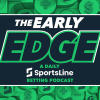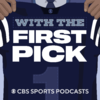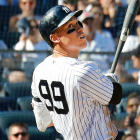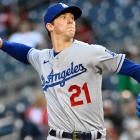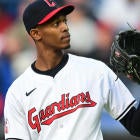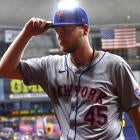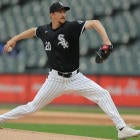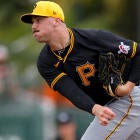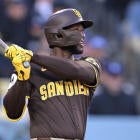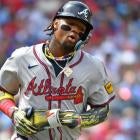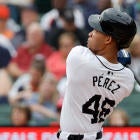We talk a lot about "range of outcomes" in the Fantasy Baseball world, usually in the context of how wide a particular player's are.
An actual season will play out in only one way, of course, but if you entered the data available at the start of a season into a simulator and ran it 1,000 times, it would play out in 1,000 different ways. Still, certain outcomes would be more reliable than others, particularly for certain players.
Let's consider some of the ones that wouldn't be as reliable — the outcomes that would diverge the most from sim to sim. I've broken them down by team, looking at both the "best case" and "worst case." True, the opposite of the "best case" would itself be the "worst case," but I figured that went without saying and have offered up unique scenarios for each.
| Best case: Zac Gallen emerges as an ace for a rotation that doesn't have enough openings to go around. Eduardo Escobar confirms that 35-homer power is his new normal. Josh Rojas becomes one of those super utility guys who's better than half the lineup. David Peralta returns to 2018 production. Worst case: Ketel Marte comes back to earth, leaving the Diamondbacks without a middle-of-the-order bat. Madison Bumgarner can't hack it outside of Oracle Park. Luke Weaver struggles to pitch through elbow pain before eventually succumbing to Tommy John surgery. Archie Bradley isn't the answer to the closer role, and no one else steps up to claim it. | |
| Best case: Marcell Ozuna performs up to his peripherals, delivering even better numbers than Josh Donaldson did last year. Austin Riley emerges at third base and challenges for the team lead in homers. Mark Melancon proves to be so steady in the closer role that Will Smith isn't needed there. Some other young arm, maybe Kyle Wright or Ian Anderson, becomes a rotation fixture. Worst case: The rotation never comes together, with Mike Foltynewicz looking more like he did in the first half last year and Cole Hamels looking more like he did in the second half. Dansby Swanson still doesn't put it all together, struggling with injuries and inconsistency again. Mike Soroka's lack of strikeouts become an issue. | |
| Best case: Ryan Mountcastle establishes himself early and hits right away. Chris Davis' short-lived spring resurgence becomes the precursor for a full-scale turnaround. Adley Rutschman forces his way onto the big-league roster sooner than anyone expects. Somebody -- anybody -- steps up in the starting rotation. Worst case: Austin Hays continues to flounder, putting to rest once and for all the hope of becoming that guy we saw in the minors in 2017. Renato Nunez's 2019 proves to be a total fluke. Once again, nobody emerges as the closer. | |
| Best case: Andrew Benintendi cures whatever's ailed him the past year and a half. Eduardo Rodriguez's 2019 breakthrough proves to be more than just a matter of good health, and he emerges as a true front-liner. Nathan Eovaldi's curveball becomes a difference-maker. Michael Chavis' cuts down on the strikeouts and settles in at second base. Worst case: Xander Bogaerts' power output returns to closer to 2018 levels. Rafael Devers also takes a step back. Christian Vazquez goes back to being a non-factor with the bat. Alex Verdugo's back never gets right. | |
| Best case: Yu Darvish confirms he's back to ace form. Ian Happ builds off his late-season success, providing the lineup with another big bat. Either Jon Lester or Jose Quintana is able to recapture some of his lost form. Worst case: They're forced to turn to their minor-league system, for any reason. Craig Kimbrel's miserable 2019 showing wasn't just a case of rust, but full-on decline. Kris Bryant and Anthony Rizzo continue to slide into ordinary. Kyle Schwarber becomes unplayable against lefties again. | |
| Best case: Eloy Jimenez's strong finish paves way to an explosive season. Tim Anderson retains his batting gains from a year ago. Another of the White Sox' young pitchers, be it Dylan Cease or Michael Kopech, joins Lucas Giolito to give them two top-of-the-rotation arms. Nomar Mazara finally delivers what he never could with the Rangers. Worst case: Luis Robert's substandard plate discipline leads to a difficult transition to the majors. Yoan Moncada takes a step back rather than forward. Lucas Giolito's improvements don't hold, and he bottoms out again. Edwin Encarnacion finally runs out of steam at age 37. | |
| Best case: Nick Castellanos becomes the clutchest of free agent signings with a swing that's perfectly tailored for his new hitter-friendly environment. Trevor Bauer does a better job keeping the ball on the ground and bounces back with Cy Young-caliber numbers. Nick Senzel takes off. Jesse Winker gets back to being the on-base machine he was in 2018. Worst case: Eugenio Suarez's recovery from shoulder surgery turns out to be not so straightforward, and his power production suffers. Luis Castillo's control issues become more pronounced, causing him to lose his ace standing. Sonny Gray does the sort of thing Sonny Gray is known for. Shogo Akiyama just can't hack it in the majors. | |
| Best case: Franmil Reyes emerges as an elite power hitter on the level of Pete Alonso. Carlos Carrasco's return to the rotation is a storybook success. Mike Clevinger's velocity gains hold and he stays healthy for a full season. Domingo Santana finally finds some consistency. Worst case: Shane Bieber becomes defined more by his hard contact rate than his pinpoint control. The "bad" version of Jose Ramirez shows up again. The team struggles and is compelled to trade Francisco Lindor. Aaron Civale's lack of swing-and-miss stuff comes back to bite him, leaving question marks at the back of the rotation. | |
| Best case: German Marquez figures out a way to survive at home while continuing to dominate on the road. David Dahl finally stays healthy for a full year and bursts onto the scene. Sam Hilliard gets all the playing time he can handle and looks just like the guy who had 42 homers and 24 steals between the majors and minors last year. Brendan Rodgers makes an easy recovery from shoulder surgery and forces his way into the big-league mix. Worst case: Fading veterans Daniel Murphy and Ian Desmond perform just well enough to continue blocking the next wave of talent. Ryan McMahon's questionable batted-ball profile becomes his demise, and Garrett Hampson himself isn't good enough to pick up the slack. Scott Oberg isn't enough to stabilize the back of the bullpen when Wade Davis inevitably falters. | |
| Best case: Matthew Boyd curbs his home run tendencies enough to make the most of his swing-and-miss stuff, emerging as a true ace. A slimmed-down Miguel Cabrera picks up where he left off in spring training, recapturing his All-Star form. Joe Jimenez overcomes his inconsistencies to become a lockdown closer. Worst case: The worst versions of C.J. Cron, Jonathan Schoop and Cameron Maybin show up, making the lineup a veritable wasteland. Niko Goodrum slumps his way out of the lineup to make the situation even worse. The rebuild is stalled, with prospects like Casey Mize, Tarik Skubal and Matt Manning unable to take that next step into the big leagues. | |
| Best case: Kyle Tucker finally gets his opportunity to shine and is a breakout success. Yuli Gurriel's power breakthrough turns out not to be a total fluke, and George Springer has a strong follow-up performance himself. The back end of the starting rotation maxes out its upside, with Lance McCullers, Jose Urquidy and Josh James all emerging as Fantasy mainstays even as Forrest Whitley pushes for a promotion. Worst case: The cloud of the sign-stealing scandal weighs heavily on the entire team, impacting every hitter's production. Yordan Alvarez can't live up to his historic rookie performance, whether because of his bum knee or something else. Carlos Correa's back continues to give him trouble. Justin Verlander and Zack Greinke begin to show their age, turning a major strength into a major weakness. | |
| Best case: Adalberto Mondesi gets his swing right and goes back to being the extra-base machine he looked like he was becoming late in 2018 and early in 2019. Ryan O'Hearn builds off a big spring performance to become a legitimate middle-of-the-order threat. Whit Merrifield eschews self preservation in another lost cause of a season, getting back to being an elite base-stealer. Worst case: Jorge Soler turns out to be just a one-hit wonder, plagued by the same shortcomings that derailed his career with the Cubs. Hunter Dozier continues to fall well short of his big April performance last year. Salvador Perez struggles in his return from Tommy John surgery, becoming a liability at the plate. | |
| Best case: Anthony Rendon's power gains carry over, leading once again to first-round production. Tommy La Stella finishes what he started last year, becoming a standout second baseman who hits for average and power. Justin Upton puts his knee and toe troubles of a year ago behind him and gets back to performing at a 30-homer pace. Worst case: An abundance of caution prevents Shohei Ohtani from completely settling into a rotation spot, making him mostly just usable as a hitter in Fantasy. The season ends up being played out in Arizona, derailing the breakout chances of Dylan Bundy and Andrew Heaney from the beginning. Jo Adell's strikeout issues persist, delaying his arrival another year. | |
| Best case: Corey Seager builds off last year's strong finish and looks more like himself in his second year back from Tommy John surgery. Julio Urias makes an easy transition to the starting rotation. Alex Wood's velocity gains through his work at Driveline Baseball are such a revelation that the Dodgers struggle to find starts for Dustin May, Tony Gonsolin and Ross Stripling. Worst case: Clayton Kershaw's back betrays him again, and his velocity continues to decline. David Price becomes just an expensive placeholder for a team with several up-and-coming arms, struggling to keep his ERA below 4.50. Kenley Jansen's stuff continues to decline, to the point the Dodgers have no choice but to replace him. Gavin Lux again struggles to get going, spending an uncomfortable amount of time on the bench. | |
| Best case: Jesus Aguilar recaptures the form he showed with the Brewers in 2018, giving the Marlins a legitimate middle-of-the-order bat. Either Isan Diaz or Lewis Brinson, if not both, takes a step forward developmentally. Jon Berti hits well enough to earn semi-regular at-bats and runs well enough for Rotisserie league players to care. Any of Jazz Chisholm, Jesus Sanchez and Monte Harrison has the sort of breakthrough that necessitates a promotion to the majors. Worst case: Jonathan Villar struggles to sustain the same sort of power production outside of Camden Yards and becomes just a hollow source of stolen bases (provided he keeps his job). A hip injury turns out to be less to blame for Caleb Smith's downfall than just his poor control and fly-ball tendencies. Sandy Alcantara's encouraging finish proves to be just a mirage. | |
| Best case: Avisail Garcia leaves Ryan Braun to fight for at-bats at first base with power numbers unlike he's delivered anywhere else. Adrian Houser proves he can sustain his stuff into the sixth and seventh inning, joining Brandon Woodruff at the top of the rotation. Corbin Burnes and Freddy Peralta claim rotation spots on merit, not out of necessity. Lorenzo Cain bounces back. Worst case: Keston Hiura's strikeout issues only get worse, stunting his development. Woodruff loses a mile per hour on his fastball and doesn't have a good enough secondary arsenal to survive it. Corey Knebel proves healthy enough to close again but winds up in more of a timeshare with Josh Hader. | |
| Best case: Mitch Garver's and Miguel Sano's impressive ratios translate over full-time at-bats. The terms of Kenta Maeda's contract no longer dictate his usage, and he responds with consistent seven-inning efforts. Byron Buxton not only stays healthy but sustains his improved strikeout rate from a year ago, finally delivering on his long-awaited potential. Worst case: Jose Berrios becomes even more hittable after beginning to trend that way last year. Jake Odorizzi's fastball returns to mediocrity, and so does he. Taylor Rogers becomes just a part of a massive closer committee instead of the lead cog. The injury bug bites Josh Donaldson again. Nelson Cruz's 39 years of age finally catch up to him, and his production totally bottoms out. | |
| Best case: Edwin Diaz rediscovers his slider and returns to being an ace closer. J.D. Davis' bat remains good enough for the Mets to stomach his defense in left field. Marcus Stroman takes well to the NL and piles up enough innings to paper over his deficiencies, like WHIP and strikeout rate. Worst case: Pete Alonso's 53 homers regress to about 40, which is more in line with his batted-ball profile, and his batting average slips accordingly. Jeff McNeil's second-half power gains turn out to be a mirage. Yoenis Cespedes recovers from his leg issues just enough to interfere with an otherwise stable outfield situation. Amed Rosario stops running altogether. | |
| Best case: Masahiro Tanaka regains the feel for his splitter and becomes a quality rotation option again. James Paxton finally manages to stay healthy. J.A. Happ and Jordan Montgomery both maintain the form they showed in spring training, getting back to being the Fantasy assets they once were. Luke Voit secures the starting first base job and performs more like the OPS hog he was in the first half last year, before having core problems. Worst case: The stress fracture in Aaron Judge's rib proves to be an especially finicky injury that condemns him to an endless cycle of ramping down and ramping back up instead of just playing. Giancarlo Stanton gets hurt ... again. Gerrit Cole's fly-ball tendencies warp his ERA at Yankee Stadium. Miguel Andujar's return just leads to him stealing at-bats at left field and third base so that neither he nor Gio Urshela nor Mike Tauchman can make a substantive contribution. DJ LeMahieu's power numbers regress. | |
| Best case: Jesus Luzardo not only performs well but gets a workload that's more proportional to an ace because of the shortened season. A.J. Puk overcomes his control issues and has a breakthrough of his own. Khris Davis puts last year's hip issue behind him and gets back to being a 40-homer threat. Mark Canha manages to sustain Kris Bryant-level production over a full season. Worst case: Marcus Semien's power comes back to earth, dragging the batting average down with it. Frankie Montas' transformative splitter from a year ago looks more ordinary with increased exposure. Sean Manaea's emergence late last season turns out to be just a fluke of sample size. Liam Hendriks follows in the footsteps of Blake Treinen and goes back to being a middling reliever. | |
| Best case: Rhys Hoskins' swing changes allow for better success on balls in play, reversing his downward spiral. Bryce Harper puts together a full season more like his last four months. Jean Segura gets back to being a 20-steal guy with a more traditional manager at the helm. Spencer Howard comes up early and is good enough to stabilize a fractured rotation. Worst case: Aaron Nola continues to struggle with his command, performing like less than a true ace. Andrew McCutchen isn't the same after ACL surgery. Third baseman Alec Bohm never pushes for the big-league job, forcing the Phillies to stick with Adam Haseley in center field instead of moving Scott Kingery out there. | |
| Best case: Mitch Keller emerges as a true ace with his swing-and-miss slider. A new organizational pitching philosophy gets Chris Archer back on track and finally unlocks Joe Musgrove's potential. Gregory Polanco bounces back from an injury-plagued season with the sort of five-category production Fantasy players long expected from him. Bryan Reynolds and Kevin Newman prove not to be one-hit wonders Worst case: Josh Bell's second-half struggles continue into 2020, making him just a fringy first base option. Keone Kela proves so successful in the closer role that he's eventually traded to be some other team's setup man. Ke'Bryan Hayes finally gets called up but is just as uninspiring at the plate as he has been in the minors. | |
| Best case: Carlos Martinez picks up where he left off in the starting rotation, giving the Cardinals a true No. 2 behind Jack Flaherty. Giovanny Gallegos seizes the closer role early and is too successful to consider removing even when Jordan Hicks is back to full health. Dylan Carlson earns a job right away and immediately becomes a five-category contributor. Alex Reyes finally breaks through as a starter. Worst case: Jack Flaherty's control problems resurface, he shies away from his two-seamer again, and his dominant second half looks like just a mirage. Paul Goldschmidt's bat continues to slow, making him a liability in batting average and a disappointment overall. Tommy Edman settles into being more of a slap hitter and can't get consistent playing time. Tyler O'Neill gets most of the playing time in left and struggles to hit .220. | |
| Best case: Manny Machado adapts to his new environment and stops selling out so hard for power. MacKenzie Gore arrives looking like an immediate ace. Francisco Mejia gets off to a quick start at the plate, rendering Austin Hedges an afterthought. Wil Myers and Garrett Richards recapture their previous form. Worst case: All of the worst fears for Fernando Tatis are realized as he struggles to make contact and slows down on the base paths. Predictability becomes a problem for Chris Paddack with his two-pitch mix, and he struggles to keep the ball in the yard. Dinelson Lamet turns out to be just a tease whose wipeout slider isn't enough to sustain him a third time through a lineup. Trent Grisham never comes close to being the high-OBP power/speed threat he was in the minors last year. | |
| Best case: Mike Yastrzemski gets the everyday at-bats he deserves and rides a strong second half to a big breakout. A now 34-year-old Johnny Cueto shows he has more in the tank after Tommy John surgery. The season is partly played in Arizona, allowing Brandon Belt to reveal his true form. Worst case: Buster Posey looks like he has nothing left, but the Giants aren't in any kind of hurry to call up prospect Joey Bart. Mauricio Dubon's suspect power doesn't play at Oracle Park, and he struggles to get on base. Jeff Samardzija and Kevin Gausman are just providing batting practice for opposing teams every fifth day. | |
| Best case: Yusei Kikuchi velocity gains from spring training hold, and he becomes a legitimate asset. Mitch Haniger is well on his way to returning by the time the season starts and looks no worse for wear after core and back surgeries. Outfielder Jarred Kelenic and starting pitcher Logan Gilbert both force their way to the majors sooner than expected and deliver useful numbers right away. Worst case: Whatever strides Evan White was making as a hitter are stunted by his arrival at T-Mobile Park. Tom Murphy still can't muster anything against right-handed pitchers and ends up ceding all of those at-bats to Austin Nola. Justus Sheffield struggles to find the strike zone and reveals once and for all that his best fit is in the bullpen. Kyle Lewis' strikeout rate proves untenable, and he spends the year bouncing between the majors and minors. | |
| Best case: Hitters like Brandon Lowe, Yandy Diaz, Hunter Renfroe and Yoshitomo Tsutsugo become so productive that the Rays are forced to play them every day instead of relying on platoons. Brendan McKay's minor-league dominance begins to reveal itself in the majors. A path opens up for Nate Lowe sooner than later. Worst case: Tyler Glasnow breaks down again. Blake Snell is rarely allowed to go six and/or has another elbow flareup. Nick Anderson becomes just part of a closer committee instead of the main guy. Austin Meadows himself becomes the subject of a platoon just because that's what the Rays do. | |
| Best case: Willie Calhoun takes the next step forward in his development, becoming like an outfielder version of Mike Moustakas. Joey Gallo is able to maintain more of a line-drive approach, keeping his batting average from bottoming out. Danny Santana actually follows through on his surprise breakout. A change of scenery allows Kyle Gibson to make better use of his swing-and-miss slider. Worst case: Lance Lynn or, more likely, Mike Minor slides back into mediocrity. Last April turns out to be a precursor for Corey Kluber's decline. Nick Solak struggles to find playing time and isn't a great source of power when he does. Jose Leclerc spends another year in closer purgatory. | |
| Best case: The new approach Danny Jansen showed in spring training carries over to the regular season, leading to the breakout everyone expected last year. Bo Bichette becomes more of a base-stealer. Travis Shaw rediscovers his 2017-18 form. Matt Shoemaker stays healthy and employs his wipeout splitter to maximum effect. Worst case: Vladimir Guerrero spends the whole year trying to fix his launch angle. Cavan Biggio is buried by strikeouts and popups. Hyun-Jin Ryu struggles with his new surroundings and rarely goes deep into games. Ken Giles becomes a liability in the ninth inning again. | |
| Best case: Victor Robles makes a huge leap as a hitter, becoming the five-category threat he was billed to be. Carter Kieboom puts last season's miserable debut behind him and becomes a suitable proxy for Anthony Rendon. Trea Turner stays healthy and ends any debate about whether he's a first-rounder. Worst case: Max Scherzer's neck and back issues last year become the precursor for a decline. Stephen Strasburg shows less faith in his curveball and struggles to stay healthy again. Sean Doolittle slips back into a closer platoon with Daniel Hudson or someone else. | |



